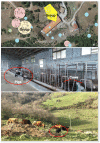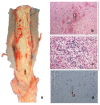First Report of a Severe Outbreak of Aujeszky's Disease in Cattle in Sicily (Italy)
- PMID: 33212860
- PMCID: PMC7709038
- DOI: 10.3390/pathogens9110954
First Report of a Severe Outbreak of Aujeszky's Disease in Cattle in Sicily (Italy)
Abstract
Aujeszky's disease in cattle is caused by Suid herpes virus 1. The natural infection has been reported worldwide in bovine species and it is related to direct and indirect contact with infected pigs, which represent the main reservoir of the virus. Here, it is reported the first documented outbreak of Aujeszky's disease in cattle in Sicily (Italy). Severe itching and nonspecific neurological symptoms were the main reported clinical signs. No characteristic gross and histological features were reported other than cutaneous lesions caused by excessive pruritus and hyperaemia, haemorrhages and inflammation in the central nervous system. Diagnosis was confirmed by real time PCR and immunohistochemistry on the nervous tissue. The route of infection remained unknown, but serological data observed in pigs living in close cohabitation with cattle revealed a circulation of a wild strain of the virus in the area. This study contributes to a better knowledge of this disease in a non-conventional host and suggests the need to increase the prophylaxis control plans in specific breeding contexts.
Keywords: Aujeszky’s disease; Suid Herpesvirus 1; cattle; immunohistochemistry; outbreak; pseudorabies.
Conflict of interest statement
The authors declare no conflict of interest due to financial or commercial relationships.
Figures









Similar articles
-
Retrieving Historical Cases of Aujeszky's Disease in Sicily (Italy): Report of a Natural Outbreak Affecting Sheep, Goats, Dogs, Cats and Foxes and Considerations on Critical Issues and Perspectives in Light of the Recent EU Regulation 429/2016.Pathogens. 2021 Oct 9;10(10):1301. doi: 10.3390/pathogens10101301. Pathogens. 2021. PMID: 34684250 Free PMC article.
-
Aujeszky's disease in hunting dogs after the ingestion of wild boar raw meat in Sicily (Italy): clinical, diagnostic and phylogenetic features.BMC Vet Res. 2022 Jan 8;18(1):27. doi: 10.1186/s12917-022-03138-2. BMC Vet Res. 2022. PMID: 34996475 Free PMC article.
-
Aujeszky's disease (pseudorabies) virus detection in cerebrospinal fluid in experimentally infected pigs.Vet Microbiol. 1998 Feb 28;60(2-4):99-106. doi: 10.1016/s0378-1135(97)00156-9. Vet Microbiol. 1998. PMID: 9646442
-
A novel concept for the control of Aujeszky's disease: experiences in two vaccinated pig herds.Vet Rec. 1990 Feb 17;126(7):159-63. Vet Rec. 1990. PMID: 2155499
-
Comparative Pathology of Pseudorabies in Different Naturally and Experimentally Infected Species-A Review.Pathogens. 2020 Aug 4;9(8):633. doi: 10.3390/pathogens9080633. Pathogens. 2020. PMID: 32759704 Free PMC article. Review.
Cited by
-
Retrieving Historical Cases of Aujeszky's Disease in Sicily (Italy): Report of a Natural Outbreak Affecting Sheep, Goats, Dogs, Cats and Foxes and Considerations on Critical Issues and Perspectives in Light of the Recent EU Regulation 429/2016.Pathogens. 2021 Oct 9;10(10):1301. doi: 10.3390/pathogens10101301. Pathogens. 2021. PMID: 34684250 Free PMC article.
-
Aujeszky's disease in hunting dogs after the ingestion of wild boar raw meat in Sicily (Italy): clinical, diagnostic and phylogenetic features.BMC Vet Res. 2022 Jan 8;18(1):27. doi: 10.1186/s12917-022-03138-2. BMC Vet Res. 2022. PMID: 34996475 Free PMC article.
-
Serological Investigation and Genetic Characteristics of Pseudorabies Virus in Hunan Province of China From 2016 to 2020.Front Vet Sci. 2021 Dec 16;8:762326. doi: 10.3389/fvets.2021.762326. eCollection 2021. Front Vet Sci. 2021. PMID: 34977207 Free PMC article.
-
Pseudorabies Virus Infections.Pathogens. 2021 Jun 8;10(6):719. doi: 10.3390/pathogens10060719. Pathogens. 2021. PMID: 34201049 Free PMC article.
-
Overview of Control Programs for Twenty-Four Infectious Cattle Diseases in Italy.Front Vet Sci. 2021 Apr 26;8:665607. doi: 10.3389/fvets.2021.665607. eCollection 2021. Front Vet Sci. 2021. PMID: 33981747 Free PMC article.
References
-
- Caruso C., Dondo A., Cerutti F., Masoero L., Rosamilia A., Zoppi S., D’Errico V., Grattarola C., Acutis P.L., Peletto S. Aujeszky’s disease in red fox (Vulpes vulpes): Phylogenetic analysis unravels an unexpected epidemiologic link. J. Wildl. Dis. 2014;50:707–710. doi: 10.7589/2013-11-312. - DOI - PubMed
-
- Moreno A., Sozzi E., Grilli G., Gibelli L.R., Gelmetti D., Lelli D., Chiari M., Prati P., Alborali G.L., Boniotti M.B., et al. Detection and molecular analysis of Pseudorabies virus strains isolated from dogs and a wild boar in Italy. Vet. Microbiol. 2015;177:359–365. doi: 10.1016/j.vetmic.2015.04.001. - DOI - PubMed

